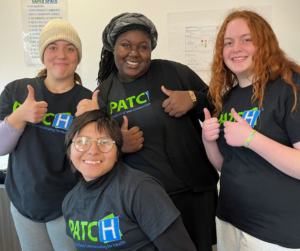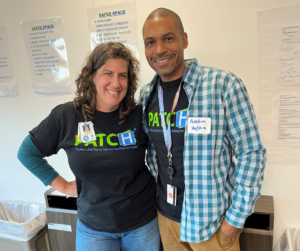By Tara Melinkovich, MPH, Youth Engagement Program Manager, Denver Health Pediatrics at Denver Public Schools
Introduction
Adolescence is a time of major change. Teens often feel awkward as they navigate the physical and emotional changes occurring between childhood and adulthood. The experience of both providing and receiving medical care at this stage in life is unlike any other time.
Adolescent health providers are well positioned to support the teen transition to adulthood by empowering their patients to take ownership of their health and develop independence in addressing their health care needs.
Most medical providers are highly motivated to learn directly from teens about how to better connect with adolescent patients.
About the Denver Health Pediatrics Program and Replicating the PATCH Program
 Denver Health Pediatrics at Denver Public Schools runs primary care offices in 19 schools across the Denver Public Schools network. These types of clinics are known as School-based Health Centers. Our staff love working with teens, and they also know it can be tricky to earn their trust. When teens do not trust adults, it’s often valid. Mistrust often occurs when adults in a teen’s life do not recognize the teen’s strengths and resilience in a fast-changing, complex world and instead look at the teen only as a risk-taker whose brain is still developing.
Denver Health Pediatrics at Denver Public Schools runs primary care offices in 19 schools across the Denver Public Schools network. These types of clinics are known as School-based Health Centers. Our staff love working with teens, and they also know it can be tricky to earn their trust. When teens do not trust adults, it’s often valid. Mistrust often occurs when adults in a teen’s life do not recognize the teen’s strengths and resilience in a fast-changing, complex world and instead look at the teen only as a risk-taker whose brain is still developing.
Staff at our program understand teens and recognize that youth are experts in their own needs. Our staff has been working for years to improve the care we provide by engaging the young people we serve. When we learned about PATCH (Providers and Teens Communicating for Heath), we knew we had to bring it to Denver. The PATCH program’s VISION is to implement a supportive environment in which all youth are healthy, connected, and thriving. Moreover, their MISSION is to improve adolescent health and wellbeing alongside and in true partnership with youth.
The PATCH Teen Educator Program aims to improve the way adolescents receive, experience, and utilize health care. It complements existing adolescent health care quality initiatives by providing teen-centered education, awareness, and encouragement to both youth and health care professionals. Teen educators are hired and trained to facilitate the PATCH for Providers and PATCH for Teens: Peer-to-Peer Workshops throughout their communities.
Program Outcomes
During the replication project year, the Denver Health Pediatrics at Denver Public Schools successfully piloted the first PATCH Teen Education site in Colorado. Major activities were as follows:
- We hosted the PATCH team for a two-day in-person training of Denver School-based Health Center staff. The objective was to provide staff with a full understanding of the PATCH teen education model, and it helped us embark on a successful replication.
- We recruited and hired nine teen educators from schools with a School-based Health Center.
- We hosted a five-day (20-hour) training with the teen educators. The training content included team building, expectation setting, and training on the PATCH model and workshops.
- Our teen educators led six PATCH for Providers and two PATCH for Teens: Peer-to-Peer.
Adaptations
 Although PATCH was a very good fit for our organization, we needed to make some adaptations to effectively serve our community. The most significant adaptation we made was centering the program within our School-based Health Center program. Centering the program meant we needed to do the following:
Although PATCH was a very good fit for our organization, we needed to make some adaptations to effectively serve our community. The most significant adaptation we made was centering the program within our School-based Health Center program. Centering the program meant we needed to do the following:
- Recruit teen educators who attend schools with School-based Health Centers.
- Train teen educators on School-based Health Center resources.
- Teach teen educators how to communicate with their peers about accessing a School-based Health Center.
- Use our first enrichment meeting to develop posters promoting the School-based Health Center to distribute in schools, and
- Adapt the timeline for hiring from the PATCH model. Because we conduct teen educator recruitment exclusively through our schools with School-based Health Centers on-site, we could not recruit educators during the summer. A fall recruitment schedule worked better for our program.
Conclusions
Participating in the replication project helped us secure organizational buy-in in order to have a PATCH Denver site housed in our School-based Health Center program. The replication project also helped us develop a holistic sustainability plan to keep this program going. We would not have been as successful in establishing this program without participating in the replication project.
